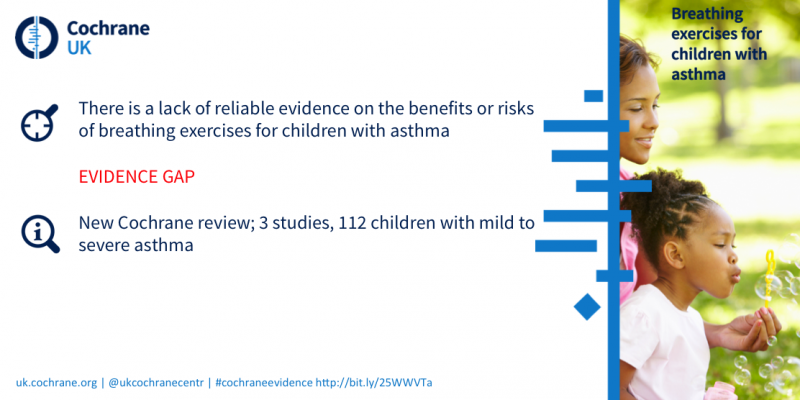
World Asthma day is an opportunity for Cochrane Airways to remind the public of some of the current evidence for asthma interventions. Our work has only been possible with the support of the National Institute of Health Research (NIHR), UK funding and fantastic teams of volunteer authors around the world.
Below are some of the reviews we have published with short conclusions and a link to the publication. We also highlight some reviews for you to look out for this coming year.
Do help share the evidence using the #WorldAsthmaDay hashtag!
Cochrane evidence on asthma
Yoga is increasingly popular and many people are interested in finding out if it might help their asthma. Our review, published in April 2016, found that yoga may improve quality of life and symptoms in people with asthma, but more high quality trials are needed to be sure of the effects. For a more personal account of the evidence from the review, please read Cochrane's Head of Communications, Julie Wood, talking about her experiencing of having asthma and using yoga to treat it.
Intravenous magnesium sulfate for treating adults and children with acute asthma in the emergency department: Some people who go to hospital with serious asthma attacks don’t get better after the standard treatments, such as oxygen, nebulisers and steroid injections. We published two reviews (one in adults and one in children) investigating whether magnesium injections might help in this situation. Both reviews found that magnesium injections may reduce the need for hospital admission, and in adults the treatment was also found to also improve lung function. However, the evidence in children is extremely limited.
Addition of long-acting beta2-agonists (LABA) to inhaled corticosteroids (ICS) for chronic asthma in children: For most people diagnosed with asthma, the first ‘preventer’ inhaler they receive is an inhaled steroid (ICS). Our review investigated whether there is a benefit of adding a different type of inhaled drug, a LABA. The review found that adding LABA to ICS was not associated with fewer asthma attacks but it did help improve lung function compared with the same or higher doses of ICS. However, there was a trend towards increased risk of hospital admission with LABA, which required further monitoring.
Intermittent inhaled corticosteroid (ICS) therapy versus placebo for persistent asthma in children and adults: Although most people with asthma are advised to take their steroid inhaler every day, it is well-recognised that some people only take their inhaler when they are having a flare-up. This review investigated whether this strategy could help to prevent a flare up getting worse. The review concluded that, compared to placebo, the use of intermittent ICS at the time of an asthma flare up reduced the chances of needing to take oral steroids by half, but the quality and amount of evidence was limited.
Our colleagues wrote a great ‘Evidently Cochrane’ blog about several of our Long-acting muscarinic antagonists (LAMA) reviews, which can be read here. For links to the individual reviews go here, here, here and here!
Stopping long-acting beta2-agonists (LABA) for adults and children with asthma well controlled by LABA and inhaled corticosteroids: While LABA inhalers can be beneficial for some people with asthma, guidelines suggest clinicians should consider stopping the LABA inhaler once asthma is back under control. This review suggested that stopping LABA in adults who have stable asthma while they are taking a combination of LABA and ICS inhalers may increase the likelihood of having an asthma attack, but this is not certain. In children, we did not find any evidence that addresses this important issue.
Macrolides for chronic asthma: A macrolide is a type of antibiotic and it has been investigated to see if it is beneficial for people with asthma when used long-term. However, despite the addition of 16 new studies to this review, no real advantage of the use of macrolides in patients with asthma was demonstrated.
Pulse oximeters used to self monitor oxygen saturation levels as part of a personalised asthma action plan for people with asthma: Some manufacturers suggest that a pulse oximeter, which measures oxygen levels in the blood, is an essential part of a home first aid kit. We wanted to find out if there was any evidence that using pulse oximeters at home was beneficial or safe for people with asthma. However, no reliable data was found to refute or endorse their use in this context.
We have a great summary on the Cochrane website about the lack of current evidence for ‘Remote versus face-to-face check-ups for asthma’.
Breathing exercises for children with asthma: showed little evidence, but our colleagues at the UK Cochrane Centre also summarised the evidence in a blog shot, one of the ways Cochrane are working on better disseminating the evidence.

Asthma reviews to look out for over the next 12 months
Non-invasive positive pressure ventilation for acute asthma in children
Different oral corticosteroid regimens for acute asthma
Exhaled nitric oxide levels to guide treatment for adults with asthma
Home telemonitoring and remote feedback between clinic visits for asthma (currently published as 'Asthma monitoring with remote feedback from a health professional')
Vilanterol and fluticasone furoate for asthma
